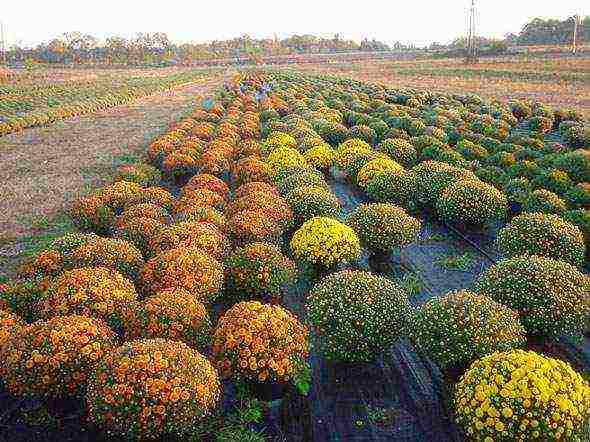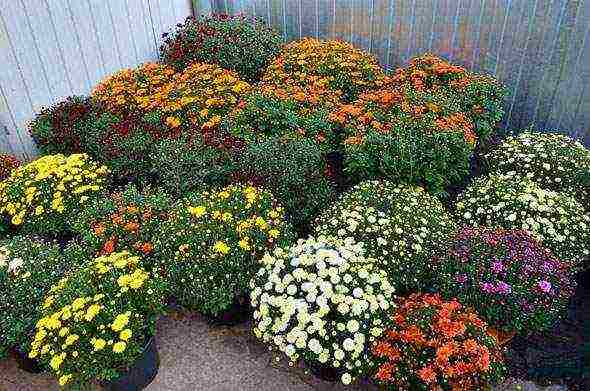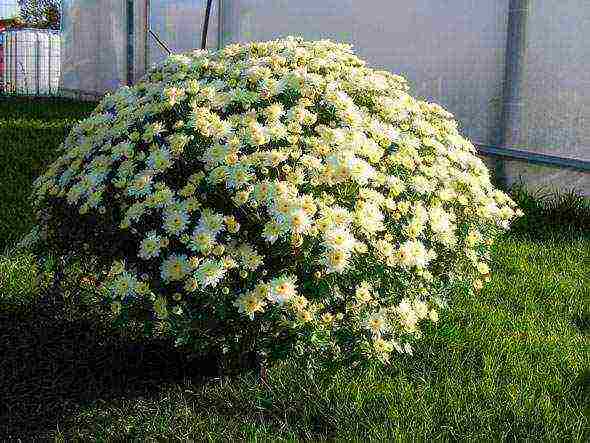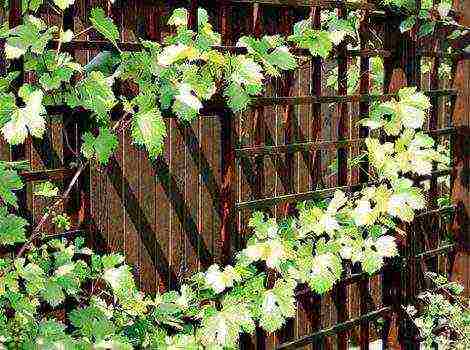Content [show]
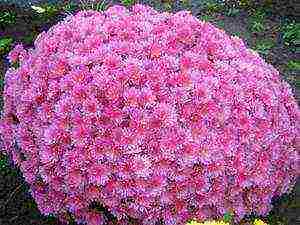 From the middle of summer until the very frost, many homesteads, summer cottages and front gardens are decorated with bright bushes of garden chrysanthemums. The plant blooms even when many flowers have already withered after the first frost. Even the most experienced gardeners are amazed at the variety of flower colors, types and shapes. You can learn about the varieties and characteristics of growing the "Queen of Autumn" by reading our article. And photos of chrysanthemums will help you choose the types of flowers suitable for the garden.
From the middle of summer until the very frost, many homesteads, summer cottages and front gardens are decorated with bright bushes of garden chrysanthemums. The plant blooms even when many flowers have already withered after the first frost. Even the most experienced gardeners are amazed at the variety of flower colors, types and shapes. You can learn about the varieties and characteristics of growing the "Queen of Autumn" by reading our article. And photos of chrysanthemums will help you choose the types of flowers suitable for the garden.
Varieties and varieties of garden chrysanthemums with photos
Garden chrysanthemum is a perennial plant whose height depends on the species and can be from 15 to 150 cm... Currently, a large number of varieties of chrysanthemums are known, which, according to some features and characteristics, are combined into groups.
The size of the inflorescences
Perennial chrysanthemums are divided into three groups according to the diameter of the flowers:
- small-flowered;
- mid-flowered;
- large-flowered.
Small-flowered or Korean plants can be simple and double. A large number of inflorescences grow on one bush with a flower diameter of 2-10 cm... The bushes themselves can reach a height of 25 to 120 cm. The leaves of the plant are in the form of oak leaves.Flowers are frost-resistant, undemanding to the composition of the soil and easy to care for. Their flowering begins in mid-September and continues until the very frost.
Mid-flowered or ornamental chrysanthemums can be grown not only for garden decoration, but also for cutting. They also grow well in pots at home. They can be used to decorate balconies, loggias and terraces. Ornamental shrubs grow up to 30-70 cm, and have a flower diameter of 10-18 cm.
Large-flowered chrysanthemums are spectacular tall plants. The length of their stem can reach from 80 to 120 cm. They bloom in large flowers with a diameter of 10-25 cm. This type of chrysanthemum does not tolerate frost well. Only some of its varieties can winter outdoors. Such flowers are intended mainly for cutting into bouquets.
The shape and height of the bush
 According to the shape and height of the bush, garden chrysanthemums are divided into three types, each of which has many varieties.
According to the shape and height of the bush, garden chrysanthemums are divided into three types, each of which has many varieties.
Tall. The stems of this type of garden chrysanthemum can be very tall and require supports such as frames, metal nets, or wooden pegs. Supports are installed during the planting of the bushes. Plants planted in a group can be used as a hedge. Most popular varieties tall garden chrysanthemums are:
- "Amber Lady" - the plant is distinguished by golden inflorescences.
- "Umka" - chrysanthemums with white flowers, the shape of which resembles a pompom.
- "Daughter of Rosetta" is strewn with flat inflorescences with flowers of pink and white shades.
Medium-sized. Bushes growing up to 30-50 cm look very impressive both on a flower bed and along paths, fences, arbors. With their help, you can realize various design fantasies. The best varieties of medium-sized garden chrysanthemums are considered:
- "Dawn" - the plant has a yellow-brown color, which is just right for the autumn mood.
- "Dune" is a truly magical variety, the flowers of which can change their color during flowering. They bloom yellow-brown, and after a few days they turn yellow-gold.
- "Lily" will help to add brightness to any composition with its dark crimson flowers.
Curb. Small plants grow up to only 30 cm. This type of chrysanthemum is considered one of the most beautiful garden flowers. Bushes of curb chrysanthemums have the shape of a ballcovered with small flowers. In this group, the most popular varieties:
- "Barbara" is a plant with delicate lilac-purple flowers.
- "Evening Lights" - the variety is distinguished by scarlet inflorescences that resemble a festive fireworks.
- "Talisman" is strewn with bright beetroot-crimson flowers.
Flower shape
Garden chrysanthemums have five different kinds of flower shapes:
-
 Pompom flowers are an assembly of tongues that are assembled into a ball that resembles a pompom.
Pompom flowers are an assembly of tongues that are assembled into a ball that resembles a pompom. - Anemoid flowers consist of large petals, which are collected in one, two or three rows. The flowers themselves are small in size and very similar to anemone flowers.
- Single-row and double-row inflorescences are bordered by flowers that look like tongues. In the center of such inflorescences, small tubular flowers grow. The border of flowers can be arranged in one or two rows.
- Semi-double flowers consist of three rows of reeds that are arranged around a central flower.
- Terry inflorescences are similar to semi-double ones, but their flowers are more lush, since they are diverse in appearance and shape.
Garden chrysanthemums - planting and care
It is recommended to plant a plant during the period from late May to mid-June... Until autumn, the bushes will have time to take root and get stronger. And then they will not be afraid of any winter frosts.
Landing features
Chrysanthemums love sunny areas. The plant requires a lot of light to set flower buds. Even in partial shade, chrysanthemums will not bloom.
The soil must be rich in organic matter.Therefore, during digging, one bucket of manure, compost or peat must be added to one square meter of soil. You don't need to add more organic matter, otherwise only leaves will grow rapidly on the bush, and the plant will bloom with very small flowers.
When planting a garden chrysanthemum, it is recommended:
-
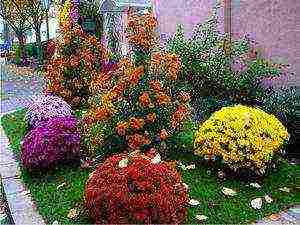 For large bushes, the distance between the holes should be at least 50 cm, and for small bushes - 25 cm.
For large bushes, the distance between the holes should be at least 50 cm, and for small bushes - 25 cm. - It is recommended to add drainage or sand to each hole.
- When planting, the plant cannot be deeply deepened into the ground.
- Near large, tall bushes, you must immediately install a support.
- The leaves of the plant can be sprayed with Epin to help it adapt better. "Kornevin" is also suitable, with a solution of which the bush is watered.
- If frosts are still expected, then the young bush should be covered with non-woven material at night.
Care rules
When caring for a garden chrysanthemum, special attention should be paid to watering it, since the plant depends on soil moisture level... You need to water the bushes in a timely manner, otherwise the flower will throw off all the buds.
The amount of water for watering one bush depends on its characteristics. Plants with small, stiff leaves can be watered less frequently than shrubs with soft, large leaves that evaporate a lot of moisture.
Chrysanthemums respond well to feeding. For this, complex mineral fertilizers containing magnesium and potassium, and organic fertilizers in the form of humates are used. During the active growth of green mass, the plant is fed with nitrogen.
Caring for garden chrysanthemums involves forming a bush. It is necessary regularly pinch and trim... For the first time, the top of the plant is removed when the central shoot grows to 10 cm. After a while, when the lateral shoots grow up to 10 cm, they also pinch the crown. After that, the bush grows to bloom.
During the period when the chrysanthemum blooms, faded and wilted buds should be regularly removed from its bush. This way the flowering period can be extended.
If you want to get large beautiful flowers, you can make a total pruning of side shoots. As a result, only one stalk and one peduncle will remain on the bush. All the forces of the plant will go to the formation and growth of the flower.
Winter garden chrysanthemum care
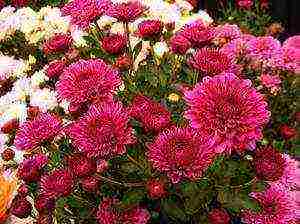 In order for a plant planted in the garden to bloom as beautifully and profusely next year, you need to make sure that it overwinters well.
In order for a plant planted in the garden to bloom as beautifully and profusely next year, you need to make sure that it overwinters well.
In frosty winters even cold-resistant varieties require shelter... Therefore, after the end of flowering, the stems of the bushes are cut to the ground. The plant is huddled and covered with fallen leaves.
Chrysanthemums with large flowers are afraid of freezing temperatures. Therefore, they need to be dug out together with an earthen lump and planted in a suitable container. Plants are stored before planting in the spring in a room with a temperature of 0-5 degrees. Caring for them consists in rarely watering an earthen coma, which should not dry out.
Diseases and pests of perennial chrysanthemums
With proper care, the plant is rarely affected by pests and practically does not get sick. However, the bushes need to be inspected regularly in order to identify the problem as soon as possible and begin to treat the plant. The threat to garden chrysanthemums is posed by:
- Spider mite is a pest that sucks juice from a plant. It can be found by the cobweb formations on the back of the sheet. If the leaves of the chrysanthemum turn gray-brown, begin to darken and fall off, then, most likely, a tick has settled on it. The plant must be treated with special chemicals.
- Leaf nematodes - the disease is manifested by deformation of the leaves, and their darkening between the veins. In this case, you need to change the soil and cut off the damaged areas.
- Verticillosis is an infectious disease that spreads through the roots. Therefore, the leaves begin to turn yellow and wither from the bottom of the bush. In the initial stages, spraying with biological products will help.
- Powdery mildew first affects the leaves and buds, on which a white bloom appears. The affected parts of the plant are removed, and the bush itself is treated with Bordeaux liquid.
Reproduction of bush chrysanthemum
Chrysanthemum can propagate in three ways:
- dividing the bush;
- seeds;
- by cuttings.
Dividing the bush
The bushes can be divided in the spring, but only after the threat of frost has passed. In order for chrysanthemums to bloom better, it is recommended to divide their bushes every three years. To do this, the plant is carefully dug up and divided into several small bushes. The roots of the plant will need to be cut. Delenki are planted in the ground and watered.
Seed reproduction
In open ground sowing is done in May... For each future plant, a separate hole is dug, the distance between which should be 25 cm. 3-4 seeds are buried in one hole. For the first time, chrysanthemums should bloom at the end of summer.
Cuttings
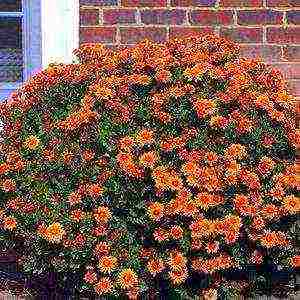 Propagation by cuttings is the easiest way, since chrysanthemums take root quickly and well.
Propagation by cuttings is the easiest way, since chrysanthemums take root quickly and well.
- A stalk with 3-4 leaves is cut under a leaf pattern. Its length should be 6-8 cm.
- The container is filled first with peat, and then with sand, into which the stalk sits.
- The soil is sprayed and the box is covered with glass.
The rooting temperature should be between 13-15 degrees. When the roots appear, the cuttings will need transplant into separate pots... Young bushes are planted in open ground only when frost has passed.
Observing the rules of planting and caring for garden chrysanthemums, you can achieve a beautiful and spectacular flowering during half summer and almost all autumn. Any part of the garden where the "Queen of Autumn" will grow will become a luxurious decoration of the garden.
Bush chrysanthemum
We suggest that you find out the names of plants for an alpine slide. The same types are suitable for decorating a rocky garden and rockery. You can see not only the names of flowers for the alpine slide, but also appreciate the beauty in the attached photos.
So, before you plants for rockeries and rock gardens in a wide variety of varieties and types:
Flat inflorescences of small flowers over openwork foliage. Unpretentious and undemanding to the soil. Well suited for cut and dry bouquets. Tall varieties should be tied to pegs. Popular border variety of Yarrow (A. filipendulina) 'Gold Plate' reaches 1.2 m in height. Felt yarrow (A. tomentosa) is suitable for rockeries.
Chrysanthemums are native to China, where they began to grow long before our era. The main purpose was the use of chrysanthemums for medical and culinary needs. Chrysanthemums with golden flowers were grown for a very long time, and only in the 5-6 centuries, see more about their cultivation here. AD, varieties were bred with white inflorescences. By this time, chrysanthemums had become very popular and the first autumn month was named after them.
Japan can rightfully be called the second homeland of these beautiful flowers.
Large-flowered chrysanthemums are spectacular tall plants. The length of their stem can reach from 80 to 120 cm. They bloom in large flowers with a diameter of 10-25 cm. This type of chrysanthemum does not tolerate frost well. Only some of its varieties can winter outdoors. Such flowers are intended mainly for cutting into bouquets.
Tall. The stems of this type of garden chrysanthemum can be very tall and require supports such as frames, metal nets, or wooden pegs. Supports are installed during the planting of the bushes. Plants planted in a group can be used as a hedge. Most popular varieties tall garden chrysanthemums are:
The soil must be rich in organic matter. Therefore, during digging, one bucket of manure, compost or peat must be added to one square meter of soil.You don't need to add more organic matter, otherwise only leaves will grow rapidly on the bush, and the plant will bloom with very small flowers.
The amount of water for watering one bush depends on its characteristics. Plants with small, stiff leaves can be watered less frequently than shrubs with soft, large leaves that evaporate a lot of moisture.
During the period when the chrysanthemum blooms, faded and wilted buds should be regularly removed from its bush. This way the flowering period can be extended.
With proper care, the plant is rarely affected by pests and practically does not get sick. However, the bushes need to be inspected regularly in order to identify the problem as soon as possible and begin to treat the plant. The threat to garden chrysanthemums is posed by:
Dividing the bush
The bushes can be divided in the spring, but only after the threat of frost has passed. In order for chrysanthemums to bloom better, it is recommended to divide their bushes every three years. To do this, the plant is carefully dug up and divided into several small bushes. The roots of the plant will need to be cut. Delenki are planted in the ground and watered.
Features of growing perennial garden chrysanthemums (small-flowered), planting and care ...
Large-flowered Indian, flowers that we often see in beautiful bouquets, they can be grown if you live somewhere in the southern regions, or you have a greenhouse or greenhouse.
Most gardeners only grow cold-resistant chrysanthemums, which we used to call Korean (oak, oak). Their origin is hybrid, there are many varieties and they are very diverse in color, size and shape. Chrysanthemum all season will delight, if not with flowers, then with its crown, foliage, a beautiful ball. And they bloom until late autumn, depending on the variety - 20-60 days.
Among small-flowered bush chrysanthemums, flowers can be double: flat, hemispherical, spherical, pompom, curly; as well as simple (chamomile): non-double, semi-double, anemone.
Can chrysanthemums be planted in autumn?
A worthy option is to buy a flowering bush in a pot in the fall, wait until the end of flowering, break off the dry stems and leave for the winter in a dry, cold basement at a temperature of 4-5 degrees Celsius. In the spring, plant chrysanthemums in open ground. The conditions for proper winter storage are described below.
Some tips for planting chrysanthemums in the fall:
The optimal time for planting is considered the end of September - the first half of October; You should not plant flowering bushes - there is a great risk that they will not take root; For planting, it is better to choose bushes on which root shoots have formed. Do not forget to mulch the soil with a layer of peat or compost, and before frost in November, it is better to cover it with something to protect it from the cold.
We will plant bush chrysanthemums.
You have purchased neat bushes of small-flowered chrysanthemums in garden centers or from private owners, or they have already been growing in the garden for more than one year and need to be planted. You can simply divide the roots into parts and plant each one separately. The plant takes root well and you will have several bushes. Before digging up the bush, water it to saturate them with moisture.
We take a bush, shake off the ground and begin to simply break it in half. Then we separate the neat well-developed sprouts with roots one by one. If a sprout is left without a root, then it can be rooted like a cutting in damp ground. The sprouts can be small, medium or large, depending on the parent shrub we choose to plant. Fill the holes with water and, like any seedlings, plant chrysanthemum plants.
The pinching procedure is one of the important points in caring for garden chrysanthemums. If we pinch correctly, then a chic bush can turn out from a small sprout.
Before planting the root, in large sprouts with leaves in several tiers, pinch the top so that the plant has 5-6 true leaves, not counting the stepsons. By removing the growth point, we thus stimulate the development of lateral shoots of the second order. If this is not done, the sprout will grow up, stepchildren will begin to appear, but not so powerful, the bush will not be so compact and not so abundant.
Caring for chrysanthemum in the garden
Loosening is carried out only in the first month after planting, so as not to damage the root system and the root growth that grows by the fall.
Cuttings are carried out in the open field, from the end of May to September. You can bend the twigs to the ground and pin them with special wire forks, so they give roots very quickly.
In the fall, when you break off the stems, there are trimmings - cuttings already ready for planting. Better to plant in special substrates designed for rooting. Either they are dipped in water and they give roots - this is the most elementary way.
Some gardeners fear that small-flowered Korean chrysanthemums may freeze in winter. In principle, in some northern regions this happens, so in October, mulch the space under the bush, cover the root system with a thick layer of peat and compost. And already in November, not earlier, so that the plant does not become rotten, cover it on top with spruce branches left after pruning coniferous trees. It is a very good cold insulating material.
You do not need to water them, otherwise the new shoots that form there will begin to grow ahead of time. Nothing good will come of this, the stems will only stretch out from a lack of light, and the roots will deplete. If the soil is too dry during storage, then you can put a couple of handfuls of snow on top of the soil, or lightly spray it with a moisturizer.
In no case do not put a pot or a lump of earth in a bag, this will cause condensation to accumulate and the sprouts under the film will begin to rot.
After digging, a couple of shoots from this bush may remain in the ground, we leave them in place in the garden, fill the hole with soil, mulch, cover with something and see what happens, whether they overwinter or not. And then we will know what to do with him for the next year. Is it worth digging them up later, or is it better to leave them for the winter in the ground.
Flower and plant names for alpine slide, rockery and rocky garden
To decorate a personal plot and form a beautiful interior, gardeners often use landscape structures: alpine slides, rock gardens, rockeries and rocky gardens. All of these facilities require careful maintenance.
Perennial flowers and plants for rockeries, rock gardens and their photos
Perennial plants for rockeries can reduce labor costs for the maintenance of this landscape structure. When choosing a plant for rockeries, you should pay attention to its decorative properties. Look at the plants for rockeries in the photo, which are presented in the description of individual species. There you will also find suitable flowers for rockeries, which can easily turn into a real garden decoration.
Flowering time... June - September Location... best sunny
Most widely grown of all rocky garden plants. Gray-green fluffy leaves are covered in masses of flowers in spring. Aubrieta deltoidea (A. deltoidea) is the main species - height 8-12 cm, grows up to 60 cm wide, but this form is not grown. Many garden varieties of pale purple, pink, red or blue color were obtained from her.
Varieties and varieties of garden chrysanthemums with photos
Garden chrysanthemum is a perennial plant whose height depends on the species and can be from 15 to 150 cm... Currently, a large number of varieties of chrysanthemums are known, which, according to some features and characteristics, are combined into groups.
The size of the inflorescences
small-flowered; large-flowered.
Small-flowered or Korean plants can be simple and double. A large number of inflorescences grow on one bush with a flower diameter of 2-10 cm... The bushes themselves can reach a height of 25 to 120 cm. The leaves of the plant are in the form of oak leaves. Flowers are frost-resistant, undemanding to the composition of the soil and easy to care for. Their flowering begins in mid-September and continues until the very frost.
Mid-flowered or ornamental chrysanthemums can be grown not only for garden decoration, but also for cutting. They also grow well in pots at home. They can be used to decorate balconies, loggias and terraces. Ornamental shrubs grow up to 30-70 cm, and have a flower diameter of 10-18 cm.
According to the shape and height of the bush, garden chrysanthemums are divided into three types, each of which has many varieties.
"Amber Lady" - the plant is distinguished by golden inflorescences. "Umka" - chrysanthemums with white flowers, the shape of which resembles a pompom. "Daughter of Rosetta" is strewn with flat inflorescences with flowers of pink and white shades.
Medium-sized. Bushes growing up to 30-50 cm look very impressive both on a flower bed and along paths, fences, arbors. With their help, you can realize various design fantasies. The best varieties of medium-sized garden chrysanthemums are considered:
"Dawn" - the plant has a yellow-brown color, which is just right for the autumn mood.
Curb. Small plants grow up to only 30 cm. This type of chrysanthemum is considered one of the most beautiful garden flowers. Bushes of curb chrysanthemums have the shape of a ball... strewn with small flowers. In this group, the most popular varieties:
"Evening Lights" - the variety is distinguished by scarlet inflorescences that resemble a festive fireworks.
Flower shape
Garden chrysanthemums have five different kinds of flower shapes:
Single-row and double-row inflorescences are bordered by flowers that look like tongues. In the center of such inflorescences, small tubular flowers grow. The border of flowers can be arranged in one or two rows.
It is recommended to plant a plant during the period from late May to mid-June... Until autumn, the bushes will have time to take root and get stronger. And then they will not be afraid of any winter frosts.
Chrysanthemums love sunny areas. The plant requires a lot of light to set flower buds. Even in partial shade, chrysanthemums will not bloom.
For large bushes, the distance between the holes should be at least 50 cm, and for small bushes - 25 cm.It is recommended to add drainage or sand to each hole. Near large, tall bushes, you must immediately install a support. The leaves of the plant can be sprayed with Epin to help it adapt better. "Kornevin" is also suitable, with a solution of which the bush is watered.
When caring for a garden chrysanthemum, special attention should be paid to watering it, since the plant depends on soil moisture level... You need to water the bushes in a timely manner, otherwise the flower will throw off all the buds.
Chrysanthemums respond well to feeding. For this, complex mineral fertilizers containing magnesium and potassium, and organic in the form of humates are used. During the active growth of green mass, the plant is fed with nitrogen.
Caring for garden chrysanthemums involves forming a bush. It is necessary regularly pinch and trim... For the first time, the top of the plant is removed when the central shoot grows to 10 cm. After a while, when the lateral shoots grow up to 10 cm, they also pinch the crown. After that, the bush grows to bloom.
If you want to get big beautiful flowers, you can make a total pruning of side shoots. As a result, only one stalk and one peduncle will remain on the bush. All the forces of the plant will go to the formation and growth of the flower.
Winter garden chrysanthemum care
In order for a plant planted in the garden to bloom as beautifully and profusely next year, you need to make sure that it overwinters well.
In frosty winters even cold-resistant varieties require shelter... Therefore, after the end of flowering, the stems of the bushes are cut to the ground. The plant is huddled and covered with fallen leaves.
Chrysanthemums with large flowers are afraid of freezing temperatures. Therefore, they need to be dug out together with an earthen lump and planted in a suitable container. Plants are stored before planting in the spring in a room with a temperature of 0-5 degrees. Caring for them consists in rarely watering an earthen coma, which should not dry out.
Spider mite is a pest that sucks juice from a plant. It can be found by the cobweb formations on the back of the sheet. If the leaves of the chrysanthemum turn gray-brown, begin to darken and fall off, then, most likely, a tick has settled on it. The plant must be treated with special chemicals. Leaf nematodes - the disease is manifested by deformation of the leaves, and their darkening between the veins. In this case, you need to change the soil and cut off the damaged areas. Verticillosis is an infectious disease that spreads through the roots. Therefore, the leaves begin to turn yellow and wither from the bottom of the bush. In the initial stages, spraying with biological products will help.
Reproduction of bush chrysanthemum
Chrysanthemum can propagate in three ways:
dividing the bush; seeds; by cuttings.
Small-flowered garden chrysanthemum: planting and care
Galina September 2, 2015, 14:37
We have a special relationship with chrysanthemum, this is the flower that is always nice to remember! To get compact flowering bushes, garden chrysanthemums need to be well cared for, planted, watered and fed on time, properly shaped, divided and cuttings.
Without going into the details of the classification, we will divide all chrysanthemums conditionally into two types:
Shrub varieties, small-flowered, very beautiful and compact-looking chrysanthemums - we especially highlight the group of Korean hybrids (Chrysanthemum? Koreanum), most often grown in the middle lane.
In terms of landscape design, chrysanthemum is a very interesting flowering plant. She is one of the first to appear in the spring, the flower itself, of course, blooms in the fall, but its foliage is small, so carved, slightly silvery in color, looks great in any color combinations, in harmony with many garden plants.
Most experts in this field believe that the autumn planting of perennial chrysanthemums should be carried out only in warm regions, giving preference for this to small-flowered varieties. In addition, this is the most common time when planting material is sold in the markets. Florists have the opportunity to evaluate the bush, its height, size and color of the inflorescences. If you buy chrysanthemums for planting in the spring, it remains to follow at random, since it is quite difficult to predict anything, looking at the still bare branches.
It is better to buy early flowering chrysanthemums no later than September, besides, the plant should be blooming profusely.
Flowering seedlings are typically sold by cut flower growers and late flowering varieties are often grown in their greenhouses to prolong flowering. The next fall, the chrysanthemum does not have time to bloom in our gardens, because of the frost, all the long-awaited beauty disappears.
Before the frost, the planted chrysanthemums must have time to get stronger in order to endure the winter frosts well.
Choosing a place for planting chrysanthemums.
First of all, it should be an open, well-ventilated and sunlit place. There should be no constant wind and draft, at the same time there should be no stagnation of air.
It cannot be planted in lowlands so that the root system is not flooded with water.It is advisable to plant on small hillocks so that in case of heavy rainfall, the water goes down and does not stagnate in the roots.
If you want to plant chrysanthemums in sandy soil, fill with good compost, humus, as it loves fertile soil. A bush on too fertile soil can grow to the detriment of flowering.
We prepared the site in advance, divided it into grooves. The distance between the holes is small, almost close, so that between the bushes it turns out 35-40 cm, small border compact bushes can be planted denser - 20-25 cm. It is advisable to add some kind of organic fertilizer or compost to each hole. Since the roots of a young plant are still weak, mineral fertilizers are not poured into the planting hole, otherwise we risk "burning" the roots.
In early spring, 1 time in 3 years, multiple shoots should be planted. We dig out the whole mulched bush when the regrown shoots reach a height of 5-7 cm.
How the bush is formed correctly.
For curbs, re-pinching will not work, it will simply grow in such a round ball, and for those chrysanthemums that are taller, you will have to pinch again on second-order shoots, leaving 3-4 leaves.
Chrysanthemum is not a plant for the lazy and requires constant care, including planting. As already mentioned, the bush is regularly pinched to increase bushiness due to the growth of lateral shoots.
In June-July, be sure to water chrysanthemums abundantly, especially when the first buds appear. In no case do not sprinkle its crown, watering should be only under the root system. In August, watering can be stopped - the flowering period begins. Reacts well to a decrease in night temperature.
Top dressing is done in spring and summer, once every 2 weeks with mineral and organic fertilizers. At the beginning of growing young chrysanthemums, it is better to use nitrogen fertilizers to build up the green mass, later phosphorus-potassium fertilizers for better flowering.
Wintering conditions for chrysanthemums in the middle lane.
You can dig a chrysanthemum bush into some container, add earth and store it in a cold cellar. Do not forget to break off the dried stems. Digging with a shovel, you should retreat from the main stem further away, since the bush grows in a circle and gives offspring at a distance of up to 20 cm.Practice shows that chrysanthemums overwinter quite successfully at a temperature of 4-5 degrees, and in the spring they are transferred to the ground again.
If you bought chrysanthemums with large flowers, white or yellow, which are sold for cutting, they are most likely Indian large-flowered varieties. In our climate, they do not hibernate at all and simply do not have time to bloom, it is not even worth experimenting. Plant them in some container and also put them in the cellar. And then large-flowered garden species of chrysanthemums have their own subtleties in growing, which must be discussed separately.
chrysanthemum curb care
How to keep the curb chrysanthemum?
Marina Mironova Student (109), closed 4 years ago
Today I bought a border chrysanthemum. How can I keep it until spring? It is still in bloom and has a lot of buds. Can it be planted in a large flower pot and kept in the house?
? Elena m? Higher Mind (557678) 4 years ago
Chrysanthemum feels good in the house at temperatures no higher than 18 degrees. With a warmer content, the buds can dry out, the inflorescences quickly fade, the leaves turn yellow.
A bright and cool window is the best place to keep a chrysanthemum in the house.
After the end of flowering, cut the potted chrysanthemum and put it for the winter in a cold place with a temperature of about +3 degrees.
Transplant the plant into fresh substrate in March.
Cut the shoots growing at the chrysanthemum several times to form a beautiful bush (the resulting cuttings can be rooted).
Often, flower growers regret their indoor chrysanthemum and cut it a little during the period of active growth, and as a result they get a long, bare plant with poor flowering.
After the end of the spring frosts, the pot with the chrysanthemum that has overwintered in the apartment can be taken out to the balcony or garden until the beginning of flowering or the onset of autumn cold weather.
Chrysanthemum roots do not need to adhere to narrow norms of soil acidity, however, the reaction of the soil should not be acidic.
Potted chrysanthemum grows better in a fertile and loose substrate (a mixture of turf or ordinary garden soil, humus, weakly decomposed peat in equal volumes).
Chrysanthemum is demanding to maintain a light moisture content of the substrate, overdrying the earth is harmful. Flower growers growing potted chrysanthemums should remember to water these plants moderately.
If the chrysanthemum has formed a lot of buds, and you need it to bloom faster, remove some of the ovaries. This technique will speed up the onset of flowering of the plant, and the opened inflorescences will be larger.
Tanya Andreeva Enlightened (29148) 4 years ago
yes, cool after flowering and away from batteries
Svetlana Svetlanova Master (1374) 4 years ago
Chrysanthemum korean
Korean chrysanthemums are a species of hybrid origin, their varieties differ in flowering period, bush height, inflorescence size, coloring of reed and tubular flowers. Korean chrysanthemum is well grown even in the middle zone of our country.
Types and varieties of Korean chrysanthemum.
By the size of the inflorescences, these chrysanthemums are divided into 2 groups: small-flowered - inflorescences 10 cm in diameter and large-flowered - more than 10 cm in diameter.
Small-flowered Korean chrysanthemums are... single-row and double-row; semi-double Korean chrysanthemums; anemone Korean chrysanthemums; pompom Korean chrysanthemums; terry Korean chrysanthemums.
In terms of height, Korean chrysanthemums are divided: into low-growing ones up to 30 cm tall, medium-sized ones - 50 cm, tall ones - about 1 m.
Border Korean chrysanthemums.
Their height is 30 cm. These chrysanthemums are characterized by an early flowering period, a dense spherical bush, and a small root growth.
Variety ‘Malchish-Kibalchish’... The bush is 28 cm tall, about 60 cm in diameter. A very profusely flowering bush, non-double inflorescences (chamomile), lilac-pinkish in color.
The size of the inflorescences is 7 cm. This variety does not give root shoots, the entire vegetative mass grows on almost one central shoot.
For a decorative effect, this chrysanthemum needs a pinch. Flowering occurs at the end of July and lasts 30-35 days. Looks great in border plantings, around apple circles, along the path.
Medium-sized Korean chrysanthemums.
Their height is 50 cm. Among these chrysanthemums there are plants of different colors with semi-double, non-double and double inflorescences.
'Amber'... Chrysanthemum 50 cm tall. Dense bush. Terry inflorescences, bright yellow. The flower is 7 cm in size. It grows well and gives root shoots.
‘Evening lights ‘. The plant is 35 cm high, and the diameter of the bush is the same. Compact bush. Inflorescences are red, around the center with a yellow ring, non-double (chamomile).
A bright, profusely blooming variety of Korean chrysanthemum. The size of the inflorescences is 5 cm in diameter, flowering lasts a month. Almost does not form root shoots.
Chrysanthemum santini, curb, undersized-Summer 2016
We accept pre-orders. Plants are reserved only on condition of prepayment. An invoice for payment is sent after placing an order and is valid for two banking days.
Unpaid orders are recalculated at prices and balances current at the time the order was sent.
We recommend choosing a delivery method by a transport company, because parcels by Ukrposhta go from 5 days or more. Plants should not be wrapped for too long.
Recommended articles:
Chrysanthemum border photos
Garden chrysanthemum: planting and care
Chrysanthemums are bright and elegant flowers that can decorate any garden or flower garden. They are quite unpretentious and do not require excessive efforts for cultivation, and most importantly, they delight with their lush flowering until late autumn. The color range of both perennial and annual chrysanthemums is extensive: their inflorescences can be white, pink, yellow, red and even greenish shades. Now there is a huge variety of varieties of chrysanthemums, but generally they can be divided into small-flowered - Korean, large-flowered - Indian. Large-flowered plants are quite capricious and are intended for growing in greenhouses or greenhouses. But small-flowered chrysanthemums take root well in the conditions of central Russia and bloom picturesquely from mid-July to late autumn. Chrysanthemums can be early, mid or late flowering. It is advisable to select plants for your summer cottage that bloom early (in July - August), since later varieties may not have time to open the buds before the onset of frost. In order to grow a strong, healthy and beautiful plant, you need to know what the garden chrysanthemum "loves". Planting and caring for the plant, including feeding and watering, must be carried out competently and in a timely manner. In this article, we will highlight the main agrotechnical features and reveal the intricacies of growing garden chrysanthemums.
Garden chrysanthemum: planting and care, plant propagation methods
This flower needs a sunny place, preferably an elevated one. The soil must be neutral or slightly acidic, always drained. Watering should be timely, but not excessive. It is advisable to use soft, settled water. Chrysanthemums are propagated by several methods: sowing seeds, cuttings or dividing the bush. Sowing of seeds is carried out at the end of February (at the beginning of March). Containers and wet soil are prepared for them. When sowing, the seeds are not covered with earth, since they need sunlight for germination. After about 7-10 days, seedlings appear, and at the end of May, the seedlings can be transferred to open ground. Unfortunately, with this breeding method, chrysanthemums will bloom only next year.
Small-flowered chrysanthemum: planting and caring for cuttings
Breeding by cuttings involves obtaining material for planting by cutting from new root shoots that appear in the mother plant after wintering. In this way, garden chrysanthemums reproduce well (photo). Planting and caring for cuttings of these flowers is not too cumbersome.
In order to get healthy and strong cuttings, the mother liquors overwintering in the basement begin to light up from February (or place them in a bright place), and in early March they are transferred to a heated greenhouse. The temperature in the greenhouse is maintained between 14 ° -20 ° C. After that, chrysanthemums are watered and treated with a urea solution, and after a day or two they loosen the soil well. When young shoots are knocked out of the mother liquor, they are cut off and treated with a growth stimulant. For cuttings, boxes are prepared, where a mixture of earth, sand and humus is placed. It is preliminarily disinfected with a manganese solution (0.3%). Cuttings are planted to a depth of about 1.5 cm, maintaining a distance of 5 cm between them. For the first week, young plants are shaded, sprayed and watered in hot weather. For rooting cuttings, the temperature is maintained from + 12 ° C to + 15 ° C. It will be possible to plant young plants in open ground after the soil warms up to + 12 ° C (approximately May-June). Until the end of July, chrysanthemum is pinched over the 6-8th leaf. Another convenient breeding method is to divide the bush. For correct division, it is necessary to wait until the danger of spring frosts has passed, and dig up the bush, and then divide its shoots. The resulting shoots are immediately planted in open ground and watered.
Chrysanthemum spherical: growing, reproduction, care.Spherical Korean chrysanthemums. How to keep chrysanthemum in winter
February 21, 2014
Gardening is surprisingly fun and aesthetically pleasing. By cultivating beautiful flowering plants, you not only decorate your backyard, but also develop your creative thinking.
A special place in the list of the most beautiful plants for the garden is taken by the spherical chrysanthemum. Beginners are literally speechless when they see its perfectly round shape and luxurious, rich colors. Despite the relatively small size (the height of the bush rarely reaches 50 cm), it is simply amazingly beautiful.
Why are these flowers so popular with gardeners?
But these flowers won the hearts of gardeners not only with their fabulous appearance:
Unlike other varieties, they often bloom even at the end of August, delighting flower growers all autumn. Due to their unique genetic properties and constant selection, they do not require any pruning and shaping at all: the bush acquires a spherical shape completely independently. But some experts say that it is more useful to pinch the tops when about four pairs of leaves appear on them. However, in 90% of cases, this event is not necessary, since the spherical chrysanthemum will acquire the necessary outlines without your intervention. In addition to the vegetable garden and garden, the bushes of this amazing plant feel great even on the windowsill, being planted in flower pots. In a word, they are everywhere capable of becoming a real decoration of the area, attracting admiring glances to themselves.
Growing and care
Of course, such beauty needs some care. Do not be afraid: these plants do not differ in anything fantastic. However, this does not at all negate the fact that the rules of their agricultural technology should be followed strictly. This will help you achieve the most impressive results.
Where and how to plant
The most difficult thing is to choose a site: in the garden, a spherical chrysanthemum should be planted in a sufficiently sunny place with good and loose soil, in which stagnation will not be observed.
Saplings should be planted as early as possible, since this is precisely the condition for their rapid growth and early flowering. In the middle lane, the most optimal landing time is the beginning of May (provided that the weather is warm enough). If there is a chance of frost, then the bushes should be covered with cut-off plastic bottles.
It is best when you have the opportunity to add special fertilizer for chrysanthemums to the planting holes. It is imperative to feed during the bud setting phase.
To do this, choose fertilizers containing mainly phosphorus and potassium (you can use banal superphosphate). Lovers of environmentally friendly farming can be advised the simplest infusion of ash.
Watering
In general, the cultivation of globular chrysanthemums largely depends on the weather in the current year. Watering especially strongly depends on this factor (which is not surprising). So, if the summer turned out to be dry, then the bushes will have to be irrigated every day, while in the rainy period they do not need watering at all.
The soil near the roots should always be moderately moist, but constant dampness and stagnation of water should not be allowed in any case.
Some remarks
If we talk about the southern regions, where the spherical chrysanthemum may well overwinter in the ground, then it is categorically not recommended to allow its vegetation in one place for more than two seasons: the plants degenerate and lose their unique round shape. That is, every two years they still have to be removed from the soil, divided and transplanted.
Reproduction
We have already said that even the most inexperienced gardeners can easily cope with the requirements that ball-shaped chrysanthemums can make. Reproduction is no exception.
Back in April, the plants should be removed from the basement (where they should be stored in winter), sprayed with water and wait for the germination to begin. When the first young buds begin to bloom on the bushes, they can begin to be divided. This approach is good because reproduction is combined with the rejuvenation of the bush.
It is all the more important to do this because old plants practically lose their decorative properties (we already wrote about this above). Even if only one bud germinates on the cut off part, it will turn out to be a full-fledged plant, the beauty of which will delight you in a few months.
Immediately after the division, young bushes should be planted in the ground or in pots. The latter is done in the event that you want to have stunning beautiful indoor flowers (we also mentioned this).
Note that the spherical chrysanthemum, the photo of which is in the article, easily propagates by cuttings. This is offensively simple: after cutting off, the stalk is placed in a glass of water and the roots are awaited. You can even immediately plant it in the ground, taking care of light shading of this area from direct sunlight.
A little about the "Koreans"
Despite the general unpretentiousness of this variety of flowering plants, even among them there are varieties that are especially suitable for growing in our conditions. These are spherical Korean chrysanthemums.
This variety is hybrid. It is divided into several types at once. The first group includes border varieties, the height of which does not exceed 30 cm. They are ideal for decorating a personal plot, since they differ in very early flowering periods, an almost complete absence of root growth and the most spherical shape of the bush.
The second type is medium-sized chrysanthemums, the height of which reaches about 50 cm. They are extremely decorative, since among the plants of this group there are varieties with an extremely diverse color of inflorescences.
They are great for creating a variety of group compositions. Unlike the first group, they can be used for cutting. In addition, they may well be cultivated as houseplants.
The third group includes all tall varieties. They are distinguished by late flowering, large inflorescences. Perfect for large areas. Despite its impressive size, the bush is quite compact.
"Multiflora"
This variety is not so resistant to frost, but it also has its own advantages. These chrysanthemums belong to medium-sized varieties, rarely reaching 50 cm. Because of this, they can be recommended for decorating flower beds and even cultivating at home.
In general, the spherical chrysanthemums "Multiflora" are distinguished by an elegant choice of shades and a relatively fast growing season (in other words, they bloom quickly). In addition, Multiflora has the most correct spherical shape, so these plants can be safely recommended for creating complex decorative compositions.
Wintering
We have already said many times that it is this stage that can bring certain difficulties to novice gardeners. This is true, but if you follow the simplest rules and your attentiveness, there is nothing wrong with that.
We have already mentioned that wintering in open ground is allowed only in the southern regions. Even in Ukraine it will be necessary to arrange basic shelters, protecting plants from possible frosts.
In the conditions of the domestic middle zone, it is completely necessary to dig out the faded bushes in October, without waiting for the onset of stable cold weather. The roots should be stored in wooden boxes covered with earth. The temperature in the room should not exceed five degrees, so a basement or insulated cellar is optimal.
Particular attention should be paid to the moisture content of the soil in the boxes: it should be slightly damp, but not damp.In general, it is best to try to maintain the natural moisture content of the substrate, since the spherical chrysanthemum, the wintering of which we are describing, in this case survives the cold period better.
Even if you cultivate these flowers in a room, then in the fall they also need to be pruned and stored in the basement. The dry and warm air of city apartments is deadly for them.
Important! In the basement or in the cellar where you store plants in the winter, in no case should there be mold and mildew. To avoid their appearance, it is imperative to establish a high-quality ventilation system.
If there are traces of fungus on the walls or on the floor, it must be scraped off, and the place should be treated with a saturated solution of copper sulfate. If not, then you can use used machine oil, which also gives good results.
Garden chrysanthemum
Chrysanthemum flowers: care, cultivation. Chrysanthemum photo
Bush chrysanthemums decorate the garden with flashes of bright colors from July to late autumn, when other plants have already completed flowering. White, yellow, pink flowers with a cold, bitter aroma are kept on chrysanthemum bushes until late autumn. This article is about lush perennial garden chrysanthemums. And about their ‘sisters’ - late-flowering greenhouse chrysanthemums with huge flowers, read here: large-flowered chrysanthemums
Garden chrysanthemums (Chrysanthemum, Dendronthema - outdated name), differ in height and shape of the bush, flowering time, color, terry, size flowers and the type of inflorescences. Some garden chrysanthemums grow up to 1.5 m, while others reach only 35-40 cm. Colors spray chrysanthemums quite extensive: white, yellow, pink... burgundy, red, orange and even green! Each color is presented in spray chrysanthemums in the widest range. Generic name chrysanthemums consists of Greek words chrysos - gold and anthos - flower .
Chrysanthemums originate from the Far East and have been known to man since ancient times. The Chinese were the first to start cultivating potted chrysanthemums already almost 3 thousand years ago. It is believed that the very first were domesticated spider chrysanthemums... which were used in cooking and medicine, and later became grow for beauty. To this day chrysanthemum remains for the Chinese a magical plant of ancient beliefs, a popular spice and a favorite indoor and home flower .
Despite the ancient culture chrysanthemum cultivation in the East, to Europe, these wonderful flowers hit only in 1789, and by 1802 the first ten chrysanthemum varieties... Unlike the East, we have, along with dear large-flowered chrysanthemums... also took root bush chrysanthemums... It is interesting that now the "western" (originally - American) fashion for bush chrysanthemums came to Japan. Bush chrysanthemums are becoming so popular both in Japanese private gardens and in bouquets... that this even causes fears of adherents of national traditions.
Types and varieties of chrysanthemums
In modern culture, there are more than 650 varieties of garden chrysanthemums... which are divided into 13 groups according to the type of inflorescence. Among spray chrysanthemums the following groups are found:
Feathery chrysanthemums have double inflorescences, petals completely hide the middle of the flower Bristly (thistle) chrysanthemums similar to feathery, but their petals are thinner, sometimes curved, and the flowers themselves resemble a brush Pompom chrysanthemums have small fully double inflorescences of almost regular round shape Simple and semi-double chrysanthemums have an almost flat inflorescence with an open core, framed by one or more rows of petals. They look like a chamomile Anemone chrysanthemums have an inflorescence similar to the previous group.However, the middle of the flower is lush and somewhat raised. Despite the name, these flowers do not closely resemble anemones. Spoon-shaped chrysanthemums resemble simple and semi-double, but their petals expand at the ends, clearly resembling a spoon Chrysanthemum fantasy relatively recently came to Europe from Japan. In fact, these are feathery chrysanthemums, but with more elongated petals.
By conditional group cold-resistant chrysanthemums are the so-called Korean chrysanthemums (oak, oak)... TO Korean chrysanthemums include hybrids of several types small-flowered garden chrysanthemums. Korean chrysanthemums very popular in cold regions (Central Russia, Siberia), where they successfully winter outdoors .
Chrysanthemums: care, cultivation
Chrysanthemums not very demanding on the chemical composition of the soil. but quite demanding on the location. They need direct sun and good drainage. In partial shade flowering chrysanthemums will not be so abundant. Chrysanthemum is characterized by increased photoperiodism (a reaction to the alternation and ratio of periods of light and darkness during the day). So, the flowering of chrysanthemums is affected by a decrease in the duration of daylight hours in autumn. In order not to break the rhythm chrysanthemums... do not plant them near garden lights or other light sources. Excessively high summer temperatures (especially at night) can also adversely affect blooming chrysanthemums .
Chrysanthemums respond well to periodic feeding: spend one common at the beginning of the season and several potash during the period of bud formation. Don't overfeed garden chrysanthemums... this will lead to the growth of long and weak greenery, susceptible to attacks by garden pests and diseases. For garden chrysanthemums are dangerous fungi, aphids. slugs and snails eating leaves and roundworms infecting roots chrysanthemums... For fungi, spray at the beginning of the season with antifungicides, and the affected parts chrysanthemums cut and destroy. Read about the fight against slugs and snails and aphids in special articles on the links. Roots chrysanthemums... infected with roundworms, keep in water with a temperature of 50 ° C for several minutes.
Some chrysanthemum varieties form tall bushes (up to 1.50 m), which require support. As a support, you can use metal or wooden pegs, connected by wire or a coarse mesh.
Prune wilted flowers regularly to prolong flowering chrysanthemums .
Chrysanthemums in winter
Cold resistance chrysanthemums - climatic zones 3-9 and depends entirely on the variety. Heat-loving chrysanthemums often freeze out, even under winter shelter. Unpretentious Korean hybrids winter well in the ground. Read more about wintering chrysanthemums in our special article: Chrysanthemums in winter.
Reproduction of chrysanthemums
Chrysanthemums propagate by cuttings, seeds or dividing bushes... Dividing the bush in early spring is the easiest and most effective method breeding chrysanthemums... Adults chrysanthemum bushes anyway need to be divided every 2-3 years. To split chrysanthemum bush... dig it out, divide the lateral shoots with a shovel into several parts with roots and transplant to new places, digging in, fertilizing and hilling properly. The central part of the bush is aging quickly, you can simply get rid of it. Chrysanthemums love hilling, as their sprawling roots form many new lateral shoots.
Reproduction of chrysanthemums by cuttings almost no problem chrysanthemum cuttings take root quite easily. If you break off the side shoot from a bouquet of chrysanthemums... standing in the water, and planting it in the soil, then it will soon give new roots and leaves (it is not a fact, however, that in a store a bouquet of chrysanthemums you come across a cold-resistant garden variety). The best time for chrysanthemum cuttings - Spring. Rooting chrysanthemum cuttings takes about two months in a warm place in a soil consisting of sand and garden soil. Rooted chrysanthemum cuttings it is necessary to pinch from above to stimulate the development of a lush crown of the bush, and transplant it into open ground.
Chrysanthemums: pruning and pinching
Shape lush bush of garden chrysanthemums a little pruning will help: pruning too long green shoots in the spring. When chrysanthemum gives young greenery, the tallest shoots are shortened at the ends to stimulate the growth of lateral shoots and the formation of a round and lush bush with many flowers .
To get a larger top chrysanthemum flower... thin out the lateral buds immediately after their formation (varieties Regalia, Dorridge Beauty ). Pinch buds until mid-June on early flowering varieties of chrysanthemums... until the end of June for the September blooming; and up to the beginning of July for the October blooming varieties.
Chrysanthemums in the garden
Bush chrysanthemums look great in the first or second rows of summer and autumn flower beds, providing bright horizontal or spherical color spots. Chrysanthemums go well with their "relatives" from the Compositae family: bush perennial asters and echinacea. and also with elegant Bonar verbena. sedum. cosmea, perovskaya. autumn anemones, dahlias and ornamental grasses and cereals. Chrysanthemums look great against the background of leaves of trees and shrubs yellowing and turning purple in autumn. Low chrysanthemums will create an excellent curb if planted, for example, along a garden path.
Cut for chrysanthemum bouquet stand in water for a long time, and dried ones will perfectly complement a winter composition of dried flowers or an aromatic potpourri.
Chrysanthemums
Growing and caring for chrysanthemums.
Blooming chrysanthemums are a real decoration of our garden in autumn. This bright and generous gift of nature with a tart wormwood aroma is as if sent to us to prolong summer days ...
History and types of chrysanthemums.
Asia is considered the birthplace of chrysanthemums. Chrysanthemums came to Europe in the middle of the 18th century, but their active spread throughout the continent began almost a century later - at the beginning of the 19th century. In Russia, the cultivation of this ornamental plant began in the 40s – 50s of the last century.
It is believed that the whole variety of chrysanthemums, called "garden" or Chrysanthemum hortorum, occurred by crossing two species from China and Japan - chrysanthemum large-flowered or Chrys. morifoolium and small-flowered chrysanthemum or Chrys. indicum.
Chrysanthemum in the biological concept is a genus of annual and perennial herbaceous plants of the Asteraceae or Asteraceae family, numbering up to 29 species and growing not only in Asia, but also in the temperate and northern latitudes of the globe.
Perennial chrysanthemums.
Among the small-flowered chrysanthemums, a group of so-called korean chrysanthemums or Ch. coreanum, which have not yet been established as an independent species. Also, the question of their origin remains unclear, so the definition of "Korean" should be considered conditional. In amateur floriculture, this type of chrysanthemum is the most popular; it is the Korean chrysanthemums that adorn the gardens of many summer cottages.
Korean chrysanthemum is distinguished by its relative resistance to low temperatures, this quality allows most varieties of chrysanthemums to winter outdoors in regions with cold winters. In addition, these flowers are famous for their abundant flowering and therefore are widely used in decorative floriculture.
What are they and when do they bloom?
Varieties Korean chrysanthemums are very different in different ways: the timing of flowering, the height of the bush, the size of the inflorescences, the color and structure of the flowers. Conventionally, this type of chrysanthemum can be divided into several groups:
curbs, the height of which is not more than 30 cm, they have an early flowering period, a dense bush, give a slight root growth; medium-sized, their height is 30-50 cm, are distinguished by a wide variety of colors and structure of inflorescences; tall chrysanthemums have a height of up to one meter, they have a large and branched bush with large inflorescences that have a late flowering period.
Mass flowering of chrysanthemums early flowering period begins in late August - early September, a month later, tall varieties of chrysanthemums enter the flowering time.
Site selection, soil, planting.
Good growth and abundant flowering of chrysanthemums is possible only if a place in the garden is properly selected for them, which should be well illuminated by the sun for at least five hours a day. It is unacceptable to plant them in damp places with stagnant water or in the shade.
The soil should be loose, breathable, rich in humus with a neutral or slightly acidic degree of acidity. You should not plant chrysanthemums in too fertilized soil to exclude the "fattening" of the plants to the detriment of flowering. Chrysanthemums are very responsive to mulching the "near-trunk" circle.
When to plant.
Planting chrysanthemums is preferable in the spring than in the fall. Plants disturbed in the fall usually do not tolerate the winter period and may die. Also, you should not plant flowers in a blooming state, therefore, if the planting material was purchased in the fall, then it is better not to leave it in the open field, but to transfer it to a room for winter storage (winter storage conditions are described below). The planting pattern is approximately 30x30 cm, for spreading bushes - 40x40 cm.
Leaving and shaping bushes.
Chrysanthemums grow very quickly. Within one season, a small stalk is able to turn into a developed bush and give abundant flowering. Therefore, special attention should be paid to feeding. The first feeding is done with nitrogen fertilizers at the initial stage of shoot growth, the next two weeks later with mullein or bird droppings. In the bud formation phase, fertilizing with phosphorus and potassium fertilizers is necessary.
In order for the chrysanthemum bush to have a beautiful shape and bloom profusely, it is necessary to shape it. To do this, from the beginning of June, they begin to do regular pinching of the tops of the shoots. A month before the beginning of flowering, make the last pinch.
In one place, chrysanthemums grow for no more than three years, that is, once every three years, in the spring the bushes must be divided. In the first year, at the beginning of the growing season, frequent loosening is carried out, which contribute to the development of the root system and the growth of underground shoots that form a bush. In the future, loosening is stopped for fear of damaging the regrown shoots.
At the end of the growing season, after the first frost, the wintering chrysanthemums must be cut and hilled. With the onset of stable frosts, the bushes were loose, so that they would not mate in the future, they were covered with spruce branches, branches or other material that trapped snow.
In early spring, the bushes are freed from spruce branches, and as soon as the growing shoots appear, the old stems are removed and the central shoot is twisted out of the ground.
Reproduction.
Reproduction by seeds.
When engaged in seed reproduction of Korean chrysanthemums, you should know that this type of reproduction gives forms that are less resistant to low temperatures and other climate features of a particular region. In addition, it should be obvious that the hybrid variety you like cannot be grown from the collected seeds.
In plants with an early flowering period with a short growing season, the seeds have time to ripen. To obtain seeds from late flowering chrysanthemums, it will be necessary to transplant them into a heated greenhouse with an air temperature of about 20?, With good ventilation and sufficient lighting. In such conditions, the seeds will ripen by November-December.
The seeds are harvested as they mature. The collected seed baskets are ripened in a warm and well-ventilated room. After two to three weeks, they are packed for storage.Storage conditions - dry and cool room with air temperature 2–5? C. The shelf life of chrysanthemum seeds is 2 years.
Sow seeds in damp seed boxes in early spring. Crops should not be covered with earth, the seeds should remain in the light, otherwise they will not germinate. If everything is done correctly, the first shoots will appear in a week.
As soon as the weather permits, the seedlings are transferred to the garden. The first flowering begins, as a rule, in the second year of the plant's life.
Propagation by cuttings.
The most popular breeding method for chrysanthemums. This is justified, since with this method all varietal characteristics are preserved. Plants grown from cuttings tolerate cold weather, they develop well and bloom luxuriantly.
Cuttings begin to be cut in the spring, when the weather is stable and warm. The selected plant should have a height of at least 20 cm. Cuttings about 10 cm long are cut from the tops of young shoots, the lower leaves are removed, then they are stuck into a box with wet soil, which should be transferred outside to a place protected from rain and wind. After two weeks, when the cuttings are rooted, the plants are transplanted to a permanent place.
Partners in the flowerbed.
Chrysanthemums go well with salvias (sage). So, sage with blue flowers will be appropriate with yellow and bronze chrysanthemums, and pale pink salvia will enhance the color perception of red chrysanthemums. The combination of chrysanthemums with plants that do not bloom, as well as with ornamental grasses and cereals is effective. Variegated plants such as coleus can be planted next to chrysanthemums. They will look good with the autumn cosme. The rich palette of Korean chrysanthemums will allow you to fully enjoy the creative delights of any gardener.
Wintering.
Not all types and varieties of chrysanthemums are able to survive our winter. Heat-loving varieties, which include most of the tall chrysanthemums with large flowers, are grown using greenhouses or dug up in late autumn for further winter storage. There are different ways of such storage.
The bushes dug out after flowering should be with a lump of earth, the young shoots of renewal should be removed. The mother bushes are tightly placed in wooden boxes and transferred for storage in a bright and cold room with an average air temperature of 2–6? C and an air humidity of no more than 80%. If there are few mother liquors, then they can be planted in different containers. Watering during storage should be minimal, the earthen lump should be kept slightly damp.
Prepared bushes are stored in a cellar, where they are transferred before the first frost. They are stacked tightly to each other on the earthen floor. The optimum temperature in the cellar should be 0–4? C.
Chrysanthemums can bloom in summer
Both storage methods allow for early (from February) germination of plants. For this, the bushes of the selected variety are brought into a room with a temperature of about 15?, The sprouts sprouted under such conditions are separated from the mother bush and planted in separate containers. About a month later, you can start forming a bush, preparing it for planting in the ground. Such germination is used when they want to achieve an earlier flowering of chrysanthemums, that is, to shift the flowering time to the summer period.
Method 3.
Storage of chrysanthemum bushes in trenches of arbitrary length and width and a depth of about 50 cm. The bushes fit tightly into the trench, the voids between the roots are filled with earth. So they are left until the first frost, which should slightly "grab" the plants, this will prevent the occurrence of fungal diseases during storage.
At the onset of frost, the trench is covered with a material that will create a frame of the "roof" of the trench, a thick layer of dry leaves is poured on top, sprinkled with earth or some kind of covering material that must be securely fixed.It should be understood that with this storage method it is difficult to control the condition of wintering plants.
Method 4.
This storage method refers to Korean chrysanthemums of early flowering and having medium-sized flowers, that is, to those plants that are resistant to low temperatures. Nevertheless, in order not to risk it, they should also be prepared for the winter cold. To do this, chrysanthemums must be cut at a distance of 10 cm from the soil surface and covered with peat in a layer of about 10-15 cm.
Chrysanthemums are annual.
All annual chrysanthemums are cold-resistant, they bloom until late autumn, without fear of frost. These are drought-tolerant and light-loving plants. They prefer fertile soils without an excess of organic fertilizers, respond well to fertilizing with mineral fertilizers. Annual chrysanthemums can be sown directly into the ground in spring. If you sow seeds for seedlings in early April, then chrysanthemums will delight you with their flowering a month earlier.
The most common types of chrysanthemums are:
keeled chrysanthemum, this is a powerful plant up to 80 cm high and large flowers, flowering begins in early August; sowing chrysanthemum, has a height of 40-60 cm and large inflorescences, flowering - the first half of August; chrysanthemum is crowned, bush height is up to one meter, inflorescences of medium size are simple and double, flowering - late July – early August; marsh chrysanthemum, low plant, spherical bush shape, small flowers, abundant flowering begins in late June; multistem chrysanthemum, height 15–25 cm, small flowers, beginning of flowering end June - early July.
All annual chrysanthemums are unpretentious and undemanding to growing conditions. Cut flowers retain their freshness in water for a long time and are very effective in autumn bouquets.
In the fall, when everything is withering around, I really want to enjoy the flowers. And such an opportunity is given by flower beds in the country, planted with late flowering plants. A bright accent of such a flower garden is chrysanthemum. Despite the fact that garden chrysanthemums are very thermophilic, they bloom well in autumn. Moreover, even small frosts do not frighten them. This explains the fact that many summer residents decide to start it and decide how to plant a chrysanthemum. It turns out that this is not difficult.
Chrysanthemums - planting and care in the open field
The place for it must be chosen so that it is well illuminated by the sun. At the same time, it must be reliably sheltered from the winds.
Before planting chrysanthemums, you need to take care of the composition of the soil of the flower garden. Heavy and dense soil is supposed to be lightened. To do this, you need to use sand and organic fertilizers. If the soil is loose and permeable to water, then the chrysanthemum bush will take root easily. And this will be a guarantee of his successful wintering. Find out more ❀ how to grow chrysanthemums in the garden from seeds + what trimming to use.

Caring for a chrysanthemum in the garden is sufficient fertilization. After watering, feed it well with mullein infusion.
Phosphorus fertilizers make it possible to form large and strong leaves, as well as prolong flowering as much as possible.
Mineral nitrogen fertilizers are recommended to be applied as foliar dressing. Because it is quickly washed out of the soil due to frequent and abundant watering, which is necessary during the period of bud formation.
The care that chrysanthemum flowers require is to protect them from pests. If aphids appear, then you need to fight with it before the buds bloom. Because then it will not be possible to cope with this pest.
It is also possible that plants are damaged by spider mites and meadow bugs. In any case, you need to use special pesticides.
An important point in caring for chrysanthemums is their wintering. Preparation should begin just before the onset of frost. At this time, perennial garden chrysanthemum is cut off. The land around the bush should be huddled and treated with a humanist.When the frost comes, cover it with spruce branches.
Chrysanthemum multiflora planting and care

Chrysanthemum multiflora
This species is characterized by a spherical bush. The advantage of this plant is that it does not require special actions to form, this is inherent in its genetics. Chrysanthemum multiflora is distinguished by abundant flowering. Moreover, the shades are represented by the entire spectrum of the rainbow.
There are recommendations to pinch the shoot after the appearance of the second pair of leaves. However, collectors claim that even without this action, the bush will still have a spherical shape.
If the pot with chrysanthemum multiflora was purchased at the end of summer or in the fall, then it must be left for the winter in a cool room. At this time, you just need to ensure that the soil does not dry out.
From the cellar, the garden pots should be exposed at the end of April. At almost the same time, it can be planted in open ground. Planting multiflora chrysanthemums is performed in pits with fertilizer. The soil must be shed well. It is recommended to place a neighboring bush no closer than 60 cm.
In the fall, all branches are supposed to be cut. This will allow you to get more shoots in the spring.
Korean chrysanthemum
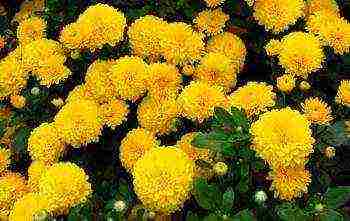 She is a hybrid. Moreover, different types of Korean chrysanthemums differ in the flowering period. They have different inflorescences with a diameter of up to 10 cm and more, as well as the height of the bush. Flowers can be reed and tubular. The color of the petals is very wide.
She is a hybrid. Moreover, different types of Korean chrysanthemums differ in the flowering period. They have different inflorescences with a diameter of up to 10 cm and more, as well as the height of the bush. Flowers can be reed and tubular. The color of the petals is very wide.
There are three groups of Korean chrysanthemums:
- undersized (up to 30 cm), which are characterized by early flowering, small roots and a dense bush, they are also called border;
- medium-sized (up to 50 cm);
- tall (up to 1 m), they have a large bush and small flowers, chrysanthemums are characterized by late flowering.
Like other varieties, these chrysanthemums are perennial, planting and caring for which is no different from others. The sun, warmth and loose soil are the key to their successful flowering.
Chrysanthemums bush planting and care with formation
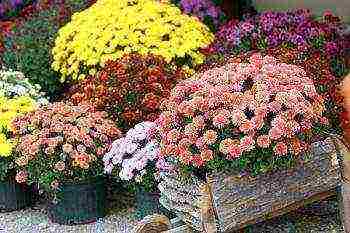 These plants have a high growth rate. In one season, the stalk is able to develop into a full-fledged bush. And in order for it to have the correct and beautiful shape, it is necessary to carry out the formation.
These plants have a high growth rate. In one season, the stalk is able to develop into a full-fledged bush. And in order for it to have the correct and beautiful shape, it is necessary to carry out the formation.
Pinching the tops of the shoots should be performed from the beginning of June. This process ends a month before the beginning of flowering.
Plus, it is necessary to regularly loosen the soil around the bush in the first year in a new place. This will encourage the development of strong roots. From them, in turn, underground shoots will begin to grow. They will form a denser bush.
How to plant chrysanthemums correctly?
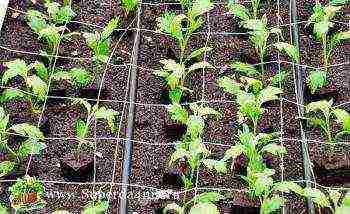 For starters, leave this for the spring. It is then that she will have enough time for full rooting. So she will be able to adapt well to wintering.
For starters, leave this for the spring. It is then that she will have enough time for full rooting. So she will be able to adapt well to wintering.
If the planting material was purchased in the form of rooted cuttings, then before transplanting the chrysanthemum, you need to wait for the onset of heat. Namely, late May - early June. The entire lump of earth from the pot must be carefully removed and planted in the prepared hole.
Chrysanthemums will take root better in a new place if, after planting, they are watered with a preparation that promotes root formation.
If the pots with the plant were stored in the cellar, then they need to be put outside for a week before planting.
Now, in the spring, it is recommended to transplant chrysanthemums. If it has been growing in one place for three years, then the bush must be moved to another place.
Chrysanthemum planting and care in the fall
Cuttings purchased at this time of the year are best taken to a cool room right away. If winters are characterized by severe frosts, then a prerequisite for how to grow a healthy and beautiful chrysanthemum will require digging it up and planting it in a spacious pot.
You need to transplant with the onset of the first frost. A bush from the ground must be taken with a large lump of soil. It must be taken into account that the roots of the plant spread deep into the soil.
The chrysanthemum pot must be moved to a cool room and pruned when the leaves begin to wither. Above the surface of the ground, you need to leave about 15 cm.
Rate the quality of the article. We want to be better for you:
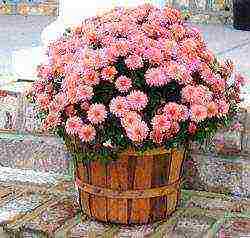 Ball-shaped chrysanthemums were bred quite recently for growing in gardens, and in a short time they managed to gain great popularity. These flowers are distinguished by their exceptional decorativeness and, at the same time, are unpretentious in their care. The flower feels great outdoors and does not cause much trouble with planting.
Ball-shaped chrysanthemums were bred quite recently for growing in gardens, and in a short time they managed to gain great popularity. These flowers are distinguished by their exceptional decorativeness and, at the same time, are unpretentious in their care. The flower feels great outdoors and does not cause much trouble with planting.
Varieties and varieties
Recently, spherical chrysanthemums have enjoyed unprecedented popularity. And the number of varieties reaches four thousand hybrids of all kinds of colors, including blue and green shades. Only viewing numerous photos will help you decide on the choice of a variety. Low bushes of chrysanthemums are densely dotted with flowers, which gives them a special charm. These plants bloom from August to the very frost.
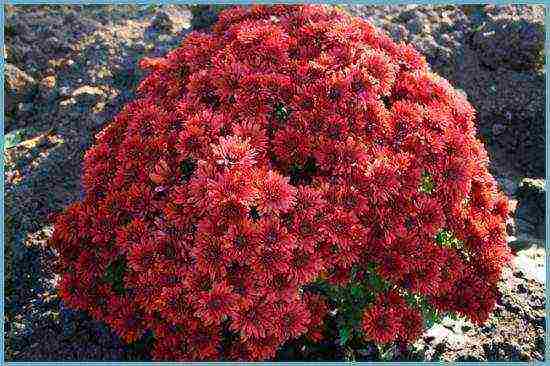
The bushes of such a chrysanthemum are in the shape of a ball, densely covered with flowers.
Some of the common varieties are:
- "Ida" is a ball-shaped bush up to 60 cm tall, dotted with small (up to 3 cm in diameter) flowers. Blooms from September.
- "Knop" - is distinguished by abundant flowering. A short bush (30-35 cm) during flowering is completely covered with yellow flowers, the number of which reaches 160 flowers at a time.
- Multiflora is the most widespread variety. Small flowers have a very wide range of colors. Blooms from early September.
Planting a globular chrysanthemum
When grown from seeds, chrysanthemums lose varietal properties, therefore these flowers are planted with shoots. The place for the plant must be chosen illuminated. In the shade, the flower can stretch out and change the timing of flowering. Chrysanthemum prefers nutritious and loose soil. In addition, good drainage will also play an important role in the development of the plant.
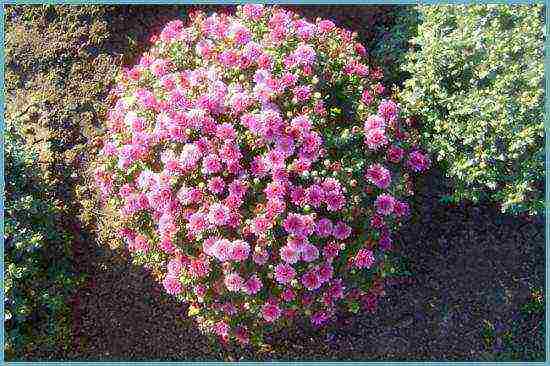
Spherical chrysanthemums propagate by cuttings
Planting cuttings is best on days when the sun is out. If this is not possible, then for a few days after planting it is advisable to shade the plant a little, but in such a way that the shelter and the cuttings do not touch. Shoots are planted in pits up to 40 cm deep. The hole must be well watered, a drainage layer should be laid and covered with a mixture of earth and vermicompost in a ratio of 20: 1. It is not necessary to overburden the sprouts.
Advice. If you are planting a tall variety, then take care of the support.
Chrysanthemum care
Often, gardeners recommend a pinching procedure on the 20th day after planting in the ground. To do this, it is necessary to remove the upper part of the shoot, on which several nodes are located. Pinching is done in order to form a spherical shape of the bush. However, there are also such growers who argue that the form is genetically embedded in this type of chrysanthemum, and pinching can be omitted.
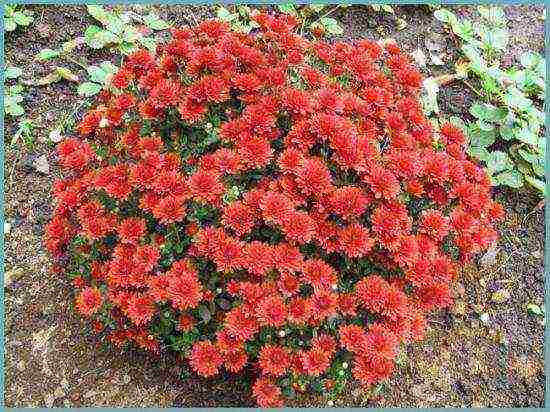
Water the plant often, but not liberally.
Watering plays a significant role in proper care. Compliance with simple rules will preserve the splendor of spherical chrysanthemums and prevent lignification of young shoots. In the hot summer, chrysanthemums need frequent but moderate watering.
Advice. Chrysanthemums will be grateful if you water them with rain or settled water.
Despite the fact that spherical chrysanthemums are a perennial culture, it is not recommended to grow it in one place for more than two years in a row. This leads to the degeneration of the variety and the modification of the shape of the bush, the shoots are stretched out and turn pale. Therefore, it is recommended to dig up the plant every two years, divide and replant. This is especially true in the southern regions, where the plant is left for wintering in the open field.

Perennial chrysanthemums should be transplanted to a new location every 2 years.
After the chrysanthemums have faded, the stems are cut to 10 cm and the chrysanthemum is prepared for wintering. In the southern regions, flowers are simply left in the ground, without additional preparations.In the middle lane, the plant can be covered for the winter with spruce branches or other covering material, if the temperature does not drop too low in winter. If the winters are harsh and, moreover, snowless, it is recommended to dig up chrysanthemums for wintering and transplant them into flowerpots, which are stored in a dark, cool place until spring.
Attention. If there is fungus or mold in the basement or cellar in which you plan to leave the chrysanthemum for the winter, this can destroy the plant. To avoid the appearance of unwanted organisms, it is necessary to equip good ventilation, and treat the damaged walls with copper sulfate or used engine oil.
You can wake up a chrysanthemum in a flowerpot as early as April, and the shelter must be removed from the garden right after the onset of heat in order to prevent the flowers from getting wet.
Fertilization and feeding
Globular chrysanthemums are among those flowers that are better undernourished than overfed. Therefore, gardeners recommend feeding a one-time feeding - in the spring at the beginning of the season. Most often, organic matter is used for this - humus or mullein. If the plant still looks weak, you can apply phosphorus-potassium fertilizers, but only before the formation of buds.
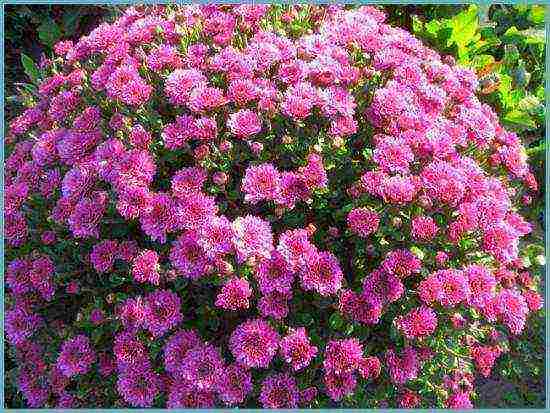
Feed your chrysanthemums with organic fertilizers
Reproduction of spherical chrysanthemum
Chrysanthemums can be propagated in three ways:
- Cuttings.
- Division of the rhizome.
- Division of the bush.
Seed propagation, as mentioned above, is not recommended due to the fact that the plant loses all varietal characteristics.
Flowers are transplanted in the spring, when the frost is completely gone. If the plant has wintered in the ground, then during this period it must be dug up and divided. It is recommended to plant the plots in a new place, at a distance of 50 cm from each other.
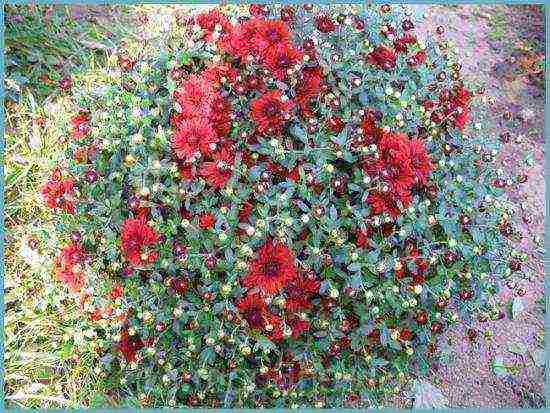
When replanting a chrysanthemum, give it enough time to root before frost.
You can propagate the plant at the end of summer, but the time must be calculated so that the chrysanthemum has time to take root before winter. If you are not sure that this is possible, it is better to plant young plants in flowerpots, and leave them to winter in a room where the temperature in winter is 4-7 C. Under these conditions, the chrysanthemum is guaranteed to overwinter and in spring young bushes can be planted in the open priming.
Advice. Remember to regularly water your plants that have been planted for the winter.
Cutting is best done in February. At this time, chrysanthemums must be planted in the greenhouse and increased watering. When young shoots appear, you need to choose the strongest ones. The length of the shoots should not exceed 10 cm. Cut cuttings are planted in a prepared mixture of sand, garden soil and humus and covered with glass or foil. After 3-4 weeks, the plants are already enough to root for planting in pots, and when the last frosts have passed, the culture can be planted in open ground.
Diseases and pests
Chrysanthemum is quite resistant to various kinds of diseases, but it does not have one hundred percent immunity. Sometimes growers complain that the lower part of the plant stem is bare and the leaves turn black. This is the result of powdery mildew. It appears with waterlogging and too high density of the bush. In addition, a large temperature difference can be the cause. In case of defeat by this disease, it is necessary to treat the plants with preparations containing copper. You can also do preventive spraying in early summer.
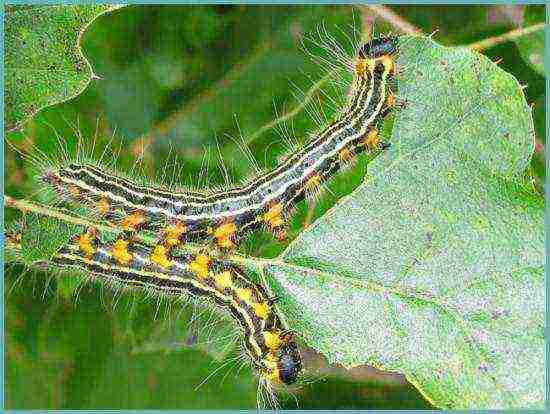
Collect caterpillars from chrysanthemum bushes regularly
Occasionally, you may find that all the leaves on the plant turn brown and begin to dry out. This means that the plant has been burned. It is recommended to remove such a bush from the garden and burn it.
Examine the plant regularly for caterpillars that can harm the flowers by eating the buds. In case of invasions of caterpillars, spider mites and aphids, it is necessary to treat the plant with special preparations that are sold in gardening stores.
Fitosporin can be added to the water for irrigation for prevention purposes. This will prevent the appearance of root rot.
Globular chrysanthemums in landscape design and in combination with other plants
If you look at the numerous photos of spherical chrysanthemums, you can see that their use in landscape design is quite diverse.
When choosing a place for chrysanthemums, it is necessary to take into account the size of the bush. Tall plants will be better combined with the same tall neighbors, and short ones, respectively, with small plants. But experimenting should not be avoided. You can plant a bed of chrysanthemums of different heights and shades, placing smaller varieties in the foreground.
Spherical chrysanthemums with conifers look great. Bright, rounded shapes smooth and liven up austere evergreen crops.
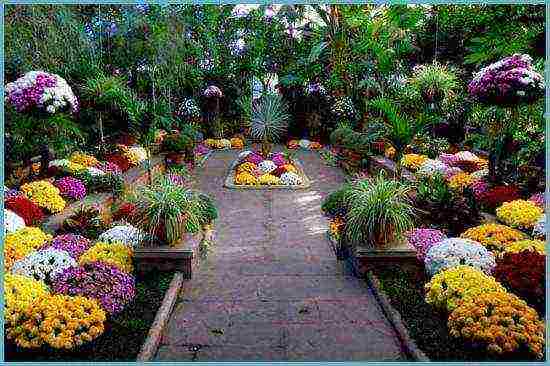
Spherical chrysanthemum in landscape design
Low-rise varieties of this perennial flower are widely used to create mixed borders. In addition, they can mark the boundaries of the beds and paths.
The variety of colors of globular chrysanthemums allows you to experiment with color combinations. For example, a green lawn would be the perfect backdrop for white chrysanthemums. And yellow flowers will look spectacular against the background of emerald grass or silver leaves of noble elimus.
Spherical chrysanthemums in combination with cereals, marigolds or cosmea will look interesting.
In autumn, when most of the plants have already faded and are getting ready for the winter, bright flower beds, composed of chrysanthemums of various colors, will delight your eye with festive flowers. Plant yellows, reds, whites and pinks and enjoy a riot of colors.
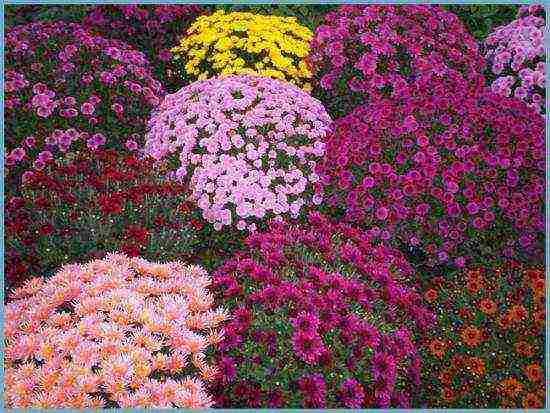
Chrysanthemums of different colors look very beautiful on the same flower bed
Ball-shaped chrysanthemums are ideal for mixborders. In addition, these lush flowers can be used as a vibrant center of the lawn, along the edges of which cold-resistant plants such as snapdragon and calendula can be planted.
Sometimes gardeners grow chrysanthemums as a home potted flower. Vases with these flowers decorate terraces and balconies. But not all varieties are able to show their full potential in a confined space.
In general, caring for chrysanthemums does not burden and does not require any special skills and abilities. In order for these beautiful autumn flowers to delight you until the very frost, it is enough to follow simple rules. A little attention and patience - and your garden will be irresistible.
Globular chrysanthemum varieties: video
Types of chrysanthemum spherical: photo
